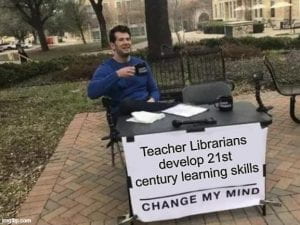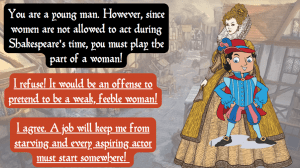Starting out, I had a narrow understanding of the various roles and responsibilities of teacher-librarians. Comparing my blog posts reveals my developed understanding (Lysaught, 2021a cf. 2021b). I had never heard the terms information literacy or fluency, and although I am working in a TL position in a school with inquiry units, they’re mainly PBL units concentrating on the product rather than directed by an information literacy model focusing on the process.

This unit emphasised that students need multiple strategies to help them find, evaluate, and apply information in their lives so they can actively and ethically participate as lifelong learners in the workforce and global community. While nominally “digital natives”, our students aren’t inherently equipped to navigate information, often taking easy solutions, giving up, or believing misinformation (Coombes, 2009; O’Connell, 2012). This unit illustrated schools must explicitly teach information literacy to develop independent, responsible, and respectful information users (Berg et. al., 2018; Kulkarni, 2021). Students must understand their rights and responsibilities as global citizens and cannot do this effectively without the necessary preparation (Lysaught, 2021c).
Information Literacy, embedded in the Australian Curriculum as the oft-forgotten and poorly implemented General Capabilities, develops the 21st century learning skills our students need to navigate increasingly popular internet and social media platforms (Jacobson, 2010; Common Sense Media, 2019; Australian eSafety Commissioner, 2021). Our Generation Z/Alpha students look to their parents as trusted news sources (Notley et. al., 2020), a problematic approach given Generation Y’s ineptitude (Coombes, 2009, p.38). Government legislation has failed to keep up with the evolving information landscape and unethical behaviours (Australian Competition and Consumer Commission, 2020, para.70). Schools must step in to fill this void.

This subject proved “information literacy is at the heart of inquiry learning” (Fitzgerald, 2015a, p.17). I now know inquiry units framed by an IL model support Generation Alpha’s preferred learning styles (McCrindle, 2019), accelerating social/emotional learning and learner autonomy (Consortium for School Networking, 2021). Inquiry learning framed by IL models benefits students, teachers, librarians, educational leaders, and parents (Maniotes et. al., 2015 p.212-215). Teacher-librarians should be familiar with multiple models to flexibly serve the learning needs of their students and so I expanded my awareness of inquiry learning models by exploring Big 6 (Big6.org, 2015), PLUS (Herring et. al. 2002, 2007, 2011), the NSW (2020) ISP and Information Fluency Framework (Wall, 2018, 2019, 2021; Cook, 2021; Grimmett, 2021). This gave me a deeper grasp of research processes, my own research methods, and an appreciation for the confused frustration that our students feel!

The ISP/GID model struck me as most useful for my context due to its emotional stages and collaborative practice (Lysaught, 2021d). My research expanded my comprehension of the way GI moves away from unenjoyable imposed questions (Gross, 2006, p.31) to promote the Third Space Merger (Maniotes et. al., 2015, p.22-23) and authentic learning for an authentic audience (Sorensen, 2019, p.30). Crucially, GI encourages transfer of skills across learning areas (Garrison & Fitzgerald, 2017). I envisage GI being successful at my school, though I need to ensure adequate time, planning, resourcing, and staff buy-in: “If you want to go fast, go alone; if you want to go far, go slow” (Leung et. al., 2021).
One prevailing misconception is teacher-librarians primarily focus on books and reading (Lysaught, 2021a). While improving literacy is important, it isn’t the teacher-librarian’s sole responsibility (Herring, 2007, p.29). Bonanno (2011a) states we should promote our specialist services, look for ways to be relevant, and “claim our space” to avoid becoming an “invisible profession”. I’ve learned teacher-librarians, as information and curriculum specialists, are uniquely positioned to teach information literacy explicitly and develop transliterate communities in ways other teachers are not (Lysaught, 2021e). Research repeatedly shows the positive impacts trained teacher-librarians have on student achievement (Bonanno, 2011b). Active teacher-librarians – supported by and collaborating with their colleagues – act as the glue connecting otherwise disparate learning areas (Lysaught, 2021e, 2021f).
As a result of my work in ETL401, I can now see many ways to positively contribute to my school’s Strategic Improvement Plan goals to enhance learning culture and wellbeing to improve student engagement, results, and belonging. In addition to improving student achievement, collaborative teaching of information literacy through inquiry learning draws together both aspects of our position – our teacher hat and librarian hat – and allows us to increase our visibility, advocate our value, and change public perceptions about our roles. What has struck me throughout this unit is the power of social media/networking as a promotional tool for teacher-librarians; as I move forward in this role I intend to continue learning from colleagues and triumphantly claim my space.
To conclude, I leave you with one final wordcloud of my ETL401 posts:

Word Count: 746
Bibliography:
Australian Competition and Consumer Commission. (2020, August 5). The ACCC’s Digital Platforms Inquiry and the need for competition, consumer protection and regulatory responses. https://www.accc.gov.au/speech/the-acccs-digital-platforms-inquiry-and-the-need-for-competition-consumer-protection-and-regulatory-responses
Australian eSafety Commissioner (2021). eSafety research: the digital lives of Aussie teens. https://www.esafety.gov.au/sites/default/files/2021-02/The%20digital%20lives%20of%20Aussie%20teens.pdf
Berg, C., Malvey, D., Donohue, M. (2018, April 7). Without foundations, we can’t build: information literacy and the need for strong school library programs. In the Library with the Lead Pipe. http://www.inthelibrarywiththeleadpipe.org/2018/strong-school-library-programs/
Big6.org (2015). Welcome to the Big6! Inquire every day and every way with the Big6! The Big6. https://thebig6.org/
Bonanno, K. (2011a). ASLA Keynote Speaker: A profession at the tipping point: time to change the game plan. [Video]. Vimeo. https://vimeo.com/31003940
Bonnano, K. (2011b). Opinion: do school libraries really make a difference? Incite 32(5), 5.
Common Sense Media (2019). The Common Sense census: media use by tweens and teens. https://www.commonsensemedia.org/sites/default/files/uploads/research/2019-census-8-to-18-key-findings-updated.pdf
Consortium for School Networking. (2021). Driving K-12 innovation: 2021 hurdles and accelerators. https://cosn.org/k12innovation/hurdles-accelerators
Cook, A. (2021). Shaping a framework for information fluency. Scan, 40(1), 4-10.
Coombes, B. (2009). Generation Y: are they really digital natives or more like digital refugees? Synergy 7(1), 31-40.
Fitzgerald, L. (2015a). Guided inquiry in practice. Scan 34(4), 16-27.
Garrison, K., & Fitzgerald, L. (2017) ‘It Trains Your Brain’: Student reflections on using the Guided Inquiry Design process. Synergy, 15(2), 1-6.
Grimmett, C. (2021). Trialling the Information Fluency Framework: a report from the pilot schools. Scan 40(9), 10-14. https://education.nsw.gov.au/content/dam/main-education/teaching-and-learning/professional-learning/scan/media/documents/vol-40/Scan_40-9_Oct2021_AEM.pdf
Gross, M. (2006). Studying Children’s Questions: Imposed and Self-Generated Information Seeking at School. Scarecrow Press.
Herring, J., Tarter, A. M., & Naylor, S. (2002). An evaluation of the use of the PLUS model to develop pupils’ information skills in a secondary school. School Libraries Worldwide 8(1), 1-24.
Herring, J. (2007). Chapter 2: Teacher librarians and the school library. In S. Ferguson (Ed.) Libraries in the twenty-first century: charting new directions in information (pp.27-42). Wagga Wagga, NSW: Centre for Information Studies, Charles Sturt University.
Herring, J., & Bush, S. (2011). Information literacy and transfer in schools: implications for teacher librarians. The Australian Library Journal, 60(2), 123-132. https://doi.org/10.1080/00049670.2011.10722584
Jacobson, H. F. (2010). Found it on the internet: Coming of age online. American Library Association.
Kulkarni, M. (2021, January 27). Young people like me need to be taught how to navigate the news. ABC Education. https://education.abc.net.au/newsandarticles/blog/-/b/3926480/young-people-like-me-need-to-be-taught-how-to-navigate-the-news?sf242496742=1
Leung, N., Radziminski, F., & Tortevski, C. (2021, August). Leading literacy change in schools [webinar]. Edutech Conference 2021, Australia.
Lysaught, D. (2021a, July 19). ETL401 assessment 1: what is the role of the teacher librarian? All You Read Is Love. https://thinkspace.csu.edu.au/allyoureadislove/2021/07/19/etl401assessment1/
Lysaught, D. (2021b, August 29). 3.2 the role of the teacher librarian: LIBERating our perceptions. All You Read Is Love. https://thinkspace.csu.edu.au/allyoureadislove/2021/08/29/3-2-the-role-of-the-teacher-librarian-liberating-our-perceptions/
Lysaught, D. (2021c, July 31). 2.5 TL in the information landscape [Online discussion comment]. Interact 2. https://interact2.csu.edu.au/webapps/discussionboard/do/message?action=list_messages&course_id=_57504_1&conf_id=_114040_1&forum_id=_244142_1&message_id=_3722025_1&nav=discussion_board_entry
Lysaught, D. (2021d, September 14). 5.4a information literacy. All You Read Is Love. https://thinkspace.csu.edu.au/allyoureadislove/2021/09/14/5-4a-information-literacy/
Lysaught, D. (2021e, September 14). 5.4b convergence. All You Read Is Love. https://thinkspace.csu.edu.au/allyoureadislove/2021/09/14/5-4b-convergence/
Lysaught, D. (2021f, September 7). 4.3 the TL and the curriculum. All You Read Is Love. https://thinkspace.csu.edu.au/allyoureadislove/2021/09/07/4-3-the-tl-and-the-curriculum/
Maniotes, L., Harrington, L., & Lambusta, P. (2015). Guided Inquiry Design® in Action: Middle School. Libraries Unlimited.
McCrindle Research (2019). GenZGenAlpha [Information card]. https://2qean3b1jjd1s87812ool5ji-wpengine.netdna-ssl.com/wp-content/uploads/2018/03/GenZGenAlpha.pdf
New South Wales Department of Education (2020). The information process. Learning across the curriculum. https://education.nsw.gov.au/teaching-and-learning/curriculum/learning-across-the-curriculum/school-libraries/teaching-and-learning
Notley, T., Dezuanni, M., Zhong, H. F., & Chambers, S. (2020). News and Young Australians in 2020: How young people access, perceive and are affected by news media. [Research Report]. Western Sydney University and Queensland University of Technology. https://www.westernsydney.edu.au/__data/assets/pdf_file/0009/1717875/News_and_Young_Australians_in_2020_web.pdf
O’Connell, J. (2012). So you think they can learn? Scan 31, 5-11.
Sorensen, A. (2019). Guided inquiry in Stage 4 history: Collaboration between teacher-librarians and classroom teachers. Teaching History, 53(4), 30-32.
Wall, J. (2018). Information + competency + literacy = fluency. A thought piece. Scan 37(6). https://education.nsw.gov.au/teaching-and-learning/professional-learning/scan/past-issues/vol-37-2018/information-competency-literacy-fluency–a-thought-piece
Wall, J. (2019). Information fluency – a path to explore and innovate? Scan 38(9). https://education.nsw.gov.au/teaching-and-learning/professional-learning/scan/past-issues/vol-38–2019/information-fluency-a-path-to-explore-and-innovate
Wall, J. (2021). Information fluency – a NSW journey. Scan 40(9), 4-9. https://education.nsw.gov.au/content/dam/main-education/teaching-and-learning/professional-learning/scan/media/documents/vol-40/Scan_40-9_Oct2021_AEM.pdf







 Throughout ETL533 I have examined how I currently incorporate digital literature into our school and considered ways to increase this in future (
Throughout ETL533 I have examined how I currently incorporate digital literature into our school and considered ways to increase this in future (











